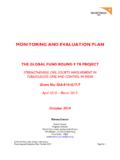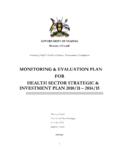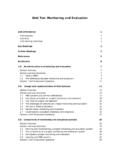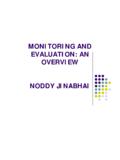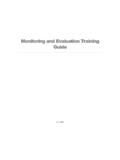Transcription of Monitoring & Evaluation Plan
1 Monitoring & Evaluation plan Transboundary Agro-Ecosystem Management Project in the Kagera Basin : Rwanda, Burundi, Uganda and Tanzania Prepared by Janie Rioux, Natural Resources/M&E Consultant Final Version Technically Cleared by the RPC and the LTU. December 2011. Table of Contents 1. M&E plan .. 3. PROJECT OVERVIEW .. 3. PURPOSE ..6. 2. M&E OF PROJECT PERFORMANCE .. 8. PROJECT IMPLEMENTATION APPROACH ..8. INDICATORS ..10. REPORTING ..11. 3. M&E OF PROJECT IMPACT .. 13. BASELINE DATA AND METHODS ..13. IMPACT ASSESSMENT METHODS ..15. SUSTAINABILITY 4. CONCLUSION AND RECOMMENDATIONS .. 17. ANNEX 1: REVIEW OF TARGET INDICATORS BY PROJECT COMPONENTS ..19. ANNEX 2: M&E MATRIX ..26. ANNEX 3 : TARGET INDICATORS FOR Monitoring AND Evaluation OF PROJECT PERFORMANCE ..41. ANNEX 4 : IMPACT ASSESSMENTS AND THEMATIC STUDIES.
2 44. ANNEX 5 : CHARACTERIZATION OF THE CATCHMENT AND SLM ACTION plan - REPORT TEMPLATE ..46. ANNEX 6: M&E REPORTING TEMPLATES ..49. 2. 1. M&E plan . The M&E plan for the Kagera Transboundary Agroecosystem Management Project (KAGERA. TAMP) has been developed by the consultant in close collaboration with the Regional Project Coordinator (RPC) and the four National Project Managers (NPMs) during collaborative and participatory work sessions in Kigali (RPC and NPMs of Rwanda and Burundi), and in Bukoba (NPMs of Tanzania and Uganda) during September 2011. Guidance and technical comments were provided by the Lead Technical Officer and budget holder of the Kagera TAMP at NRL, and will be provided if necessary by the GEF unit in TCI. The M&E plan includes two components addressing the target indicators in the project log- frame: - M&E of Project Performance Monitoring focuses on the management and supervision of project activities, seeking to improve efficiency and overall effectiveness of project implementation.
3 It is a continuous process to collect information on actual implementation of project activities compared to those scheduled in the annual work plans, including the delivery of quality outputs in a timely manner, to identify problems and constraints (technical, human resource, and financial), to make clear recommendations for corrective actions, and identify lessons learned and best practices for scaling up, etc. Performance Evaluation will assess the project's success in achieving its objectives. The project will be monitored closely by FAO. (LTU and GEF Unit) and by the Project Steering Committees through semi-annual reports, quarterly implementation reviews, technical reports, and regular technical supervision missions fielded as required to enhance success. - M&E of project impact Evaluation of the project's success in achieving its outcomes will be monitored continuously throughout the project.
4 The key indicators can be found in the logical framework. The indicators have been further reviewed/refined during the development of this M&E plan , and tools and methods and indicators for measuring impact have been be determined and agreed to ensure that a standardized framework is shared by the four participating countries. PROJECT OVERVIEW. The project's long term environmental and development goal is to support the adoption of integrated land resources management in the Kagera Basin to generate local, national and global environmental and socio-economic benefits including : restoration of degraded lands, carbon sequestration, climate change mitigation, biodiversity conservation, improved agricultural production, and thereby, protection of international waters and improved food security and rural livelihoods.
5 The project aims to reach this goal through four main components: 1. Transboundary coordination and information sharing to promote sustainable, productive agro-ecosystems and restoration of degraded lands. 3. 2. Enabling policy, planning and legislative conditions to support and facilitate the sustainable management of agro-ecosystems and the restoration of degraded land. 3. Capacity and knowledge development at all levels to promote and support sustainable management of land and agro-ecosystems in the basin. 4. Implementation of improved land and agro-ecosystem management practices benefiting land users. The transboundary issues on which the project focus are : 1. Control of soil erosion and sedimentation 2. Water management through rainwater harvesting and soil moisture management 3.
6 Reduced pressures on wetlands and fragile lands 4. Control of bush fires and reduction of biomass burning and as a result reduced Phosphorus deposition in Lake Victoria 5. Conservation of agro-biodiversity 6. Management of cross-border livestock movements and plant and animal diseases 7. Land use change and impacts on resources (including policy). Transboundary (TB) issues are being addressed with stakeholders in the four countries and through collaboration with large regional programs (NBI, LVEMP, VI-agroforestry,etc.). The Kagera TAMP will not specifically address the following TB issues that were identified during project development, notably: control of water hyacinth will be addressed by LVEMP-II ;. wildlife management and control through protected areas intervention ; and effects of water quality on health by health and water sectors.
7 Links with the wider TerrAfrica/SIP. programme will allow to share lessons learned. The project participants and partners are located at different levels : local, national, regional and global. Table 1 : Project participants and partners at all levels Levels Participants/Partners Local - Farmers mainly subsistence farmers, but also intensive perennial banana- coffee based farmers - Pastoralists/Herders - Households practicing a combination of farming or herding with fishing or forestry activities - Women and vulnerable groups - Farmers groups and associations - Local level leaders and decision makers - District authorities and government bodies National - National and international NGOs - Researchers from national institutions - The private sector - The donor community and related projects - FAO country offices 4.
8 Regional - Nile Basin Initiative (NBI). o Nile Equatorial Lakes Subsidiary Action Programme (NELSAP). o Kagera Transboundary Integrated water resources management project (TIWRMP). - Lake Victoria Environmental Management Programme (LVEMP-II). - Other regional programmes such as VI-Agroforestry (called VI-Life in Rwanda), Africa 2000, IFDC, UNECA, ICRAF, CIAT etc. Global - FAO (Land and Water Division-NRL, FAO-GEF Unit, Technical Cooperation Department -TCI)*. - GEF (Global Environmental Facility). FAO Country offices are directly involved in and provide support for project implementation (workshops, LOAs, travel, budget allocations, etc.) Information is shared with FAO Sub- regional Offices in Addis Ababa (responsible for Burundi, Rwanda and Uganda) and Harare (responsible for Tanzania) through FPMIS (reports, delivery, etc), website and communications with the regional land and water officers.
9 Kagera TAMP is funded by the Global Environmental Facility (GEF) under its Land Degradation focal area and Strategic Program (SP) for GEF-4. In line with SP1- Supporting Sustainable Agriculture and Rangeland Management, and SP3- Investing in New and Innovative Approaches for Sustainable Land Management the project focus is on restoration of the health and functioning of the different agro-ecosystems in the Kagera basin through promoting SLM at a catchment/community territory and wider transboundary levels. Land degradation and SLM will be assessed and mapped across the Kagera basin to identify and target measures to address soil erosion, loss of fertility, reduce runoff and sedimentation, increase productivity of crop and grazing lands and improve forest/energy management, as well as to improve well-being and livelihoods of land users.
10 Consistent with Strategic Objective-1 (SO-1) to develop an enabling environment for SLM. the project is working with communities and districts to demonstrate successful SLM. practices for crop, grazing and forest lands that can be integrated into relevant policies and strategies. The planning and tenure situation as well as opportunities to incentivate SLM. through PES are being reviewed for carbon sequestration and water supply and plans will be developed. Capacity development on SLM is being provided i) to farmers through setting up FFS in the selected catchments and developing and implementing SLM action plans for community territories; and ii) to district and national institutions to develop cross-sectoral interventions and apply an integrated ecosystem approach and mainstream SLM in district plans and budgets and national programmes.











